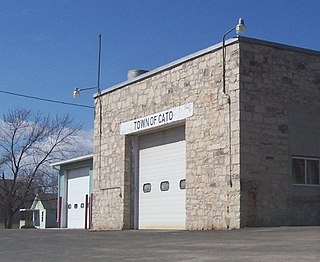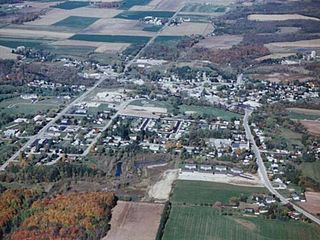
Morrison is a town in Brown County in the U.S. state of Wisconsin. The population was 1,599 at the 2010 census.

New Denmark is a town in Brown County in the U.S. state of Wisconsin. The population was 1,562 at the 2020 census. The town surrounds the village of Denmark but is separate from it. The unincorporated communities of Fontenoy and Langes Corners are located in the town. The unincorporated community of Buckman is also located partially in the town.

Cato is a town in Manitowoc County, Wisconsin, United States. The population was 1,616 at the 2000 census. A Manitowoc County park is located in the town which is called "Cato Falls" for a waterfall on the Manitowoc River.

Cleveland is a village in Manitowoc County, Wisconsin, United States. The population was 1,579 at the 2020 census.

Cooperstown is a town in Manitowoc County, Wisconsin, in the United States. As of the 2000 census, the town population was 1,403.

Francis Creek is a village in Manitowoc County, Wisconsin, United States. The population was 659 at the 2020 census. The village is located within the town of Kossuth.

Kellnersville is a village in Manitowoc County, Wisconsin, United States. The population was 307 at the 2020 census.

Kossuth is a town in Manitowoc County, Wisconsin, United States. The population was 2,033 at the 2000 census. The village of Francis Creek and the unincorporated community of Rockwood are located in the town. The unincorporated communities of Kingsbridge and Reifs Mills are also located partially in the town.

Manitowoc Rapids is a town in Manitowoc County, Wisconsin, United States. The population was 2,520 at the 2000 census.

Maple Grove is a town in Manitowoc County, Wisconsin, United States. The population was 852 at the 2000 census.

Meeme is a town in Manitowoc County, Wisconsin, United States. The population was 1,538 at the 2000 census. Its Menominee name is Omīnīw which means "pigeon". The Menominee sold this land to the United States in the 1831 Treaty of Washington.

Reedsville is a village in Manitowoc County, Wisconsin, United States. The population was 1,195 at the 2020 census.

St. Nazianz is a village in Manitowoc County, Wisconsin, United States. Founded in 1854, the population was 783 at the 2010 census.

Valders is a village in Manitowoc County, Wisconsin, United States. The population was 962 at the 2010 census.

Whitelaw is a village in Manitowoc County, Wisconsin, United States. The population was 737 at the 2020 census.

Brillion is a town in Calumet County in the U.S. state of Wisconsin. The population was 1,486 at the 2010 census.
Jefferson is a town in Jefferson County, Wisconsin, United States. The population was 2,178 at the 2010 census. The city of Jefferson is located partially within the town. The census-designated place of Helenville is also located in the town.
Manitowoc is a town in Manitowoc County, Wisconsin, United States. The population was 1,073 at the 2000 census. The city of Manitowoc divides the town into two noncontiguous sections, one north of the city and one south.

Mishicot is a town in Manitowoc County, Wisconsin, United States. The population was 1,409 at the 2000 census. The Village of Mishicot is located within the town. The unincorporated communities of Fisherville, Kingsbridge, and Tisch Mills are also located partially in the town.

Mishicot is a village in Manitowoc County, Wisconsin, United States. The population was 1,442 at the 2010 census. The village is adjacent to the Town of Mishicot.

























